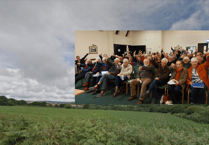RESIDENTS in Camelford were able to get an insight into a potential new housing development in the town, when Wainhomes presented their 104-unit scheme at a public exhibition recently.
Taking place in Camelford Hall last Thursday, people were given the opportunity to look at the designs for a proposed housing development at Valley Truckle, as well as meet the planning managers and those involved in the application and planning process.
The team explained that the proposed development would include 104 residential units, with 30% affordable housing — as required by law — which equals to 31 units. More specifically, the plans include 73 open market homes, 31 affordable, 22 affordable rent and nine intermediate homes.
These properties would be approximately one to four bed dwellings, offering a mixture to different target markets. Additionally, the site would also include features for residents, such as a dog walk and fitness trail, and a ‘village green’ open space area.
The house builder received pre-application advice in December 2016 from Cornwall Council, prior to the public exhibition. In the report (available on the Cornwall Council website), it states that ‘the land is currently used for grazing and is bounded by hedgerows with some mature trees’.
Furthermore, the constraints included accessibility to the town centre and its services and facilities; proximity to the town’s Special Area of Conservation and Site of Special Scientific Interest status; boundary hedges and trees; safeguarded highway route; the air quality management area status; overhead cables and a wind turbine on the adjacent land.
Wainhomes, their South West branch being based in Okehampton, have received guidance from Cornwall Home Choice in the planning process, and are positive they have presented a successful product to the people of Camelford.
Ian Roach, planning manager for the development, told the Post: “I hope the public support this. I think we’ve brought forward a positive project.”
He explained that the dwellings are ‘predominantly family homes’, with a number of bedrooms to fit the criteria of what a family would want and need. He added: “We think we’ve got a good product — a successful product.”
Wainhomes are hoping to hear if they will be granted permission for their project in the summer, and then a certain amount of time will be taken before construction. This will include an ‘option on land agreement’, which is a legal agreement with the land owner to buy the land for the proposed development. Detailed designs will also have to be drawn up, in preparation for the construction, which is expected to start in 2018 at the earliest.
Mr Roach added: “I think we have to acknowledge that where we live, we need to grow and expand. Nationally, there is a great need for housing, especially for younger people in their 20’s — it’s getting harder for them, and I think this scheme would help provide something for them.”
However, one man — Mark Benattar — came along with concerns about the development. He is a resident living directly opposite where the homes would be erected, and one of his main concerns is that the surrounding wildlife would be affected.
He told the Post at the time: “There’s rare bats in the fields, and meadow flowers. Camelford hasn’t got the schools for this, or the jobs or infrastructure — and the homes in all the other new estates still haven’t been filled, so I don’t know why they’re trying to construct another one.”
Mr Roach said an ecological survey has been carried out, taking into account all factors that could have a direct effect on both residents and the environment, adding: “They were happy that there would not be an impact.”
It states in Wainhomes’ planning application document that an ecological appraisal report had been carried out, which documents the phase 1 habitat and phase 2 species surveys undertaken at the site, along with a tree survey, an arboricultural impact assessment and tree protection plan.
Other residents in Valley Truckle have also shown their opposition to the plans, with concerns over the wildlife and wellbeing of local people.
Mr Bennatar, whose home backs onto the development, explained that wildlife was just one of his concerns, commenting on rare bats, dormice, birds and orchids, as well as the ‘beautiful field’ allegedly being mentioned in the Domesday book. He believes the proposed development is ‘an accident waiting to happen’.
He said: “Camelford has no work; it has no GP places and no school places. We’ve reached a capacity here; we haven’t got the work or facilities for it.
“Camelford has undergone a massive expansion in the last decade with lots of new estates, but the last one built hasn’t sold a single house yet in three months.”
Mr Benattar worries the construction of the proposed dwellings would ‘take at least three years to build, even if they do sell — if not longer’, and added that he does not understand why they want to build on predominantly agricultural land.
He said: “The neighbourhood plan isn’t in place — I expect the people behind that wouldn’t agree with it too. The town centre is polluted and full of empty houses; the school and doctors are full; there’s no work and all the shops are shutting.
“The first thing Camelford needs is a bypass, what with all the air management and traffic, so people can live in Camelford. They’re talking about moving people out; they should be moving the cars out, not the people.”
Mark has lived in the Valley Truckle area for 16 years, and explained that 15 years ago, there were just a handful of houses located there. Now, there are approximately 200 homes standing in the Valley Truckle area. He said from his conservatory, the development would be just ten yards away from his home, adding: “It would border onto me.”
At the exhibition, Mr Benattar said that he told Wainhomes what he thought, but was mindful that the representatives present were simply doing their jobs.
He added: “Everyone here is very upset about it — one lady said she can’t sleep because of it. I think they were probably surprised at the amount of people that actually showed up (to the public exhibition). It would ruin our house and the reason I live here. It’s an accident waiting to happen.”
Alan Trewhela, 75, who has looked after and grazed the ‘donkey field’ for 49 years, said: “It’s heartbreaking. There’s so few fields of meadow grass left that’s never had any fertiliser or anything on it but horse and donkey manure; it’s a paradise for nature.
“There’s only one exit, which will be a nightmare and means they will have to take some of the Cornish hedges down to connect the fields.”
Another resident, Dr Kim Bowen-Jones, was concerned that traffic surveys had been carried out during the quietest winter month. She said: “There will be 200 more cars driving around town if this goes ahead. The local plan wants development nearer the centre to stop further traffic pollution and keep Camelford clean and sustainable.”
She said that she was sure the town council, residents and proposed neighbourhood plan were all against the proposal, adding: “I fear national policy will override what locals want, so it will definitely be a test as to whether there really is any such thing as local democracy.”
The proposal currently includes plans for 73 open market homes, 22 affordable social houses and nine intermediate residences.
Angela McGorrin, who also attended the public exhibition, and who lives at Three Corners Close, said: “I am so upset, I can’t sleep at night. Construction will take a minimum of three years if they sell the houses. I am retired and sit in the garden painting and listening to birdsong — that’s why I bought my house.
“All that dust and noise — there won’t be any wildlife left at the end of that.”
Chris Hughes, 56, whose campsite is one of three bordering on the development, is worried about how his business may be affected. He said: “Who’s going to want to stay by a building site with loads of noise and dust? Our guests come here for peace and quiet and to enjoy nature.
“We employ four people; who knows what will happen when tourists don’t come! As for the old beech trees, they say they are protected, but they said that with the estate over the road — as soon as people moved in, they cut them down!”
The Post contacted Ian Roach, Wainhomes’ planning manager for this development, for the opportunity to comment further.
He said: “I understand that some people may be concerned — new developments are often feared because it represents change. However, the reality is that housing developments are benign once built and quickly become part of the norm.”
He believes that the homes would welcome new opportunities, and would potentially bring more money and business into the town, as well as benefitting local people.
“Our proposal is not just for 104 new houses — there would also be two play areas, a fitness trail and open space on site, as well as highways improvements and new pavements along the B3266. As with all housing developments, the new residents would spend money in Camelford and the wider area, and help to maintain facilities and services.
“We are confident that our proposed development complies with the policies in Cornwall Council’s recently adopted local plan. That plan says that Camelford is a key town in Cornwall and it has an important role to play in meeting the need for open market and affordable housing in Cornwall.”
Town mayor, Rob Rotchell, told the Post that the town council will be holding a meeting on Tuesday, May 16 at Camelford Hall to discuss the proposal, and to hear from the public.
He said: “Formally, we have decided to call a town council meeting, because it’s of such significance. We felt a meeting would allow us to consider the proposal, because it’s important — it’s a big development. At first, they were looking at 150 houses, but now it has been cut down to 104.”
Speaking of the upcoming meeting on at 7pm onMay 16, Cllr Rotchell added: “This is an opportunity for members of the public to present their views and for councillors of the town council to make a decision.”




